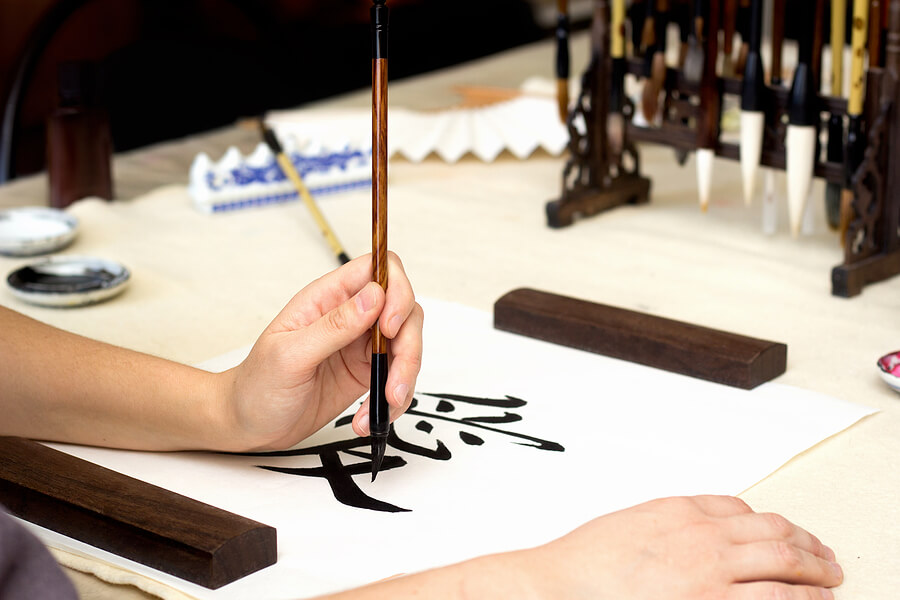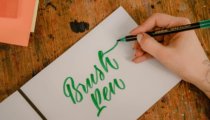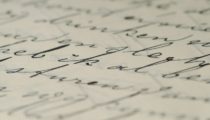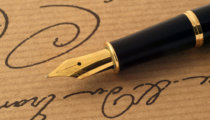‘Lettering’ is an umbrella term, used when talking about anything…
Everything you need to know about brush calligraphy
Traditional calligraphy is an intricate technique to master, but a healthy dab of dedication will give your writing an exquisite, elegant look. Unsurprisingly, jumping into this hobby nib-first can be a little intimidating for some.
Maybe it’s time to turn the page and take a closer look at brush calligraphy.
We’ve put together this guide on brush pen calligraphy for beginners, which includes what you need to get started, tips to help with your brush pen lettering, and a closer look at some of our favourite brush pens.
What is brush calligraphy?
The core difference between brush pen calligraphy and pointed pen calligraphy is the tools used. Brush lettering is created with a brush pen (or sometimes a paintbrush) with a brush-shaped tip. In contrast, classic calligraphy involves a special dip pen (with a pointed nib) and a continuous flow of fresh ink.
The same method of using alternating ‘pressure’ applies to both styles. Upstrokes are thin, requiring less pressure on the pen, while downstrokes are thicker strokes, requiring you to press your brush pen down with additional force.
Brush pen lettering is ideal for beginners as it’s easier to learn and generally offers greater control when sculpting your letters. As your writing hand isn’t tied by the strict rules of classic calligraphy, such as the spacing and slanting of your letters, brush lettering encourages you to blot creativity and expression from pen to paper.
For example, you can experiment with different kinds of textures and opt for a more “playful” look, in which the letters don’t all sit on the same line or aren’t consistently spaced out.
Tips for getting started with brush lettering
Brush lettering pens
Another fantastic lure about brush pen calligraphy is that you don’t need expensive equipment to pursue your love of hand lettering. All you need to learn brush pen lettering are two essential tools – brush pens and paper- and the appetite for practice.
Let’s start with the anatomy of a brush pen. Brush pens have become very popular in the calligraphy community, with hundreds to choose from. At first glance, they may look like a regular marker, but they’re designed to imitate the feel and fluidity you get with a watercolour paintbrush.
Brush pen tips are made from different materials. Tips made from natural hair bristles or synthetic fibre hairs are soft and flexible, closely mimicking the behaviour of a brush. A felt tip is much firmer and a sensible choice for newcomers as it offers superior control.
Synthetic and natural hair brush tips are usually more challenging to control as they react more quickly to changes in pressure but can deliver some striking and juicy heavyweight strokes.
Other factors to consider include the elasticity of your brush and its size. The springier the bristles, the quicker the tip will return to its original shape when lifted from the page. The elasticity will also affect line thickness.
Brush pens are typically labelled as either ‘fine’ or ‘broad’ to suit variable stroke widths. Broad tips are great for bold, dramatic downstrokes, while fine tips are perfect for putting the devil in detail.
Brush lettering paper
Of course, you can only get to grips with your shiny, new brush pen once you’ve got some paper to adorn with unique squiggles, beautiful letters, and wavy brushstrokes. Most types of paper are compatible for beginning your brush calligraphy journey, but quality pays – the smoother, the better.
Smoother paper won’t fray your brush pens, allowing them to glide effortlessly across the surface for maximum cleanliness and precision. HP laserjet paper is a cost-effective option for practicing brush calligraphy letters while keeping your pens in tip-top shape.
Ink and colour
The ink in your pen can also influence your choice of brush pen. Brush pen ink can be dye-based or pigmented.
Dye-based ink means that the colourant is dissolved into the ink solution, which is ideal if you want to combine colours and get creative with blending effects. That’s right, brush calligraphy isn’t only restricted to the formalities of black and blue. You can take your artwork and sketches to gaudy heights thanks to the many vivid colours found in brush pens.
On the other hand, pigment inks have tiny, insoluble particles that don’t dissolve completely. However, -based ink possesses much higher lightfastness ratings, aka an increased resistance to fading and is quick to dry. Depending on the project you’re working on, for example, a birthday card or scrapbook, you’ll want to know your brush pen’s lightfast ability. You’ll also need to check if the ink is waterproof or non-waterproof to avoid those dreaded smudges.
Finally, look out for the ink flow. Measured as wet, medium, or dry, the width at the base of the nib will also indicate your brush calligraphy pen’s ink flow. Wet tips have a higher ink surge and produce consistent, rich lines, even if you’re writing against time.
At the other end of the spectrum, you can linger dry tips on the paper for some delightful gestural effects. Just be mindful that they can create streaks of uneven ink distribution.
Perfecting your brush pen calligraphy letters

Now that you’re excited and ready to start brush lettering, here are a trio of tips to help you brush up on your technique.
- Hold your pen with a relaxed grip at about a 45-degree angle to the paper. This will enable you to apply the full amount of pressure.
- Start with the basics – chunky downstrokes and thin upstrokes. Then try them both together.
- Slow and steady wins the race. This gives you time to focus on your technique and hone in on the crucial details. It will also give your brush tip time to revert back from being pressed down, making it easier to achieve a thin upstroke.
Our favourite brush pens
Sailor 1911 Brush Pen
With authentic black ink flowing serenely no matter how hard you push, the Sailor 1911 brush pen is a comfortable size for beginners and experts alike. The synthetic brush tip offers excellent line variation for many expressions and is refillable using the Sailor brush pen cartridges.
Tombow ABT Brush Pen
Available in a staggering 95 colours, the water-based Tombow ABT brush pen is an endless palette of shades and tones. It’s a little different as it has two nibs, one at each end of the pen (one being a flexible nylon brush tip and the other a finer felt tip). The two nibs allow you to create different designs using the same pen. A blender pen is also available to help you make stunning blending effects on your illustrations.
Every calligraphy project is different, but whether it’s dunking a nib into an ink well or brush stroking your words one letter at a time, you’ll find all the writing tools and inspiration you need here at The Pen Company.



